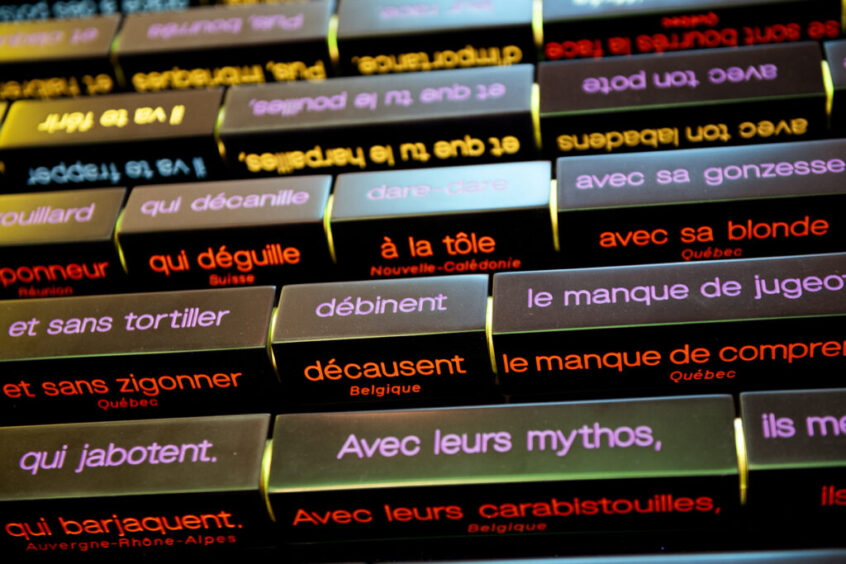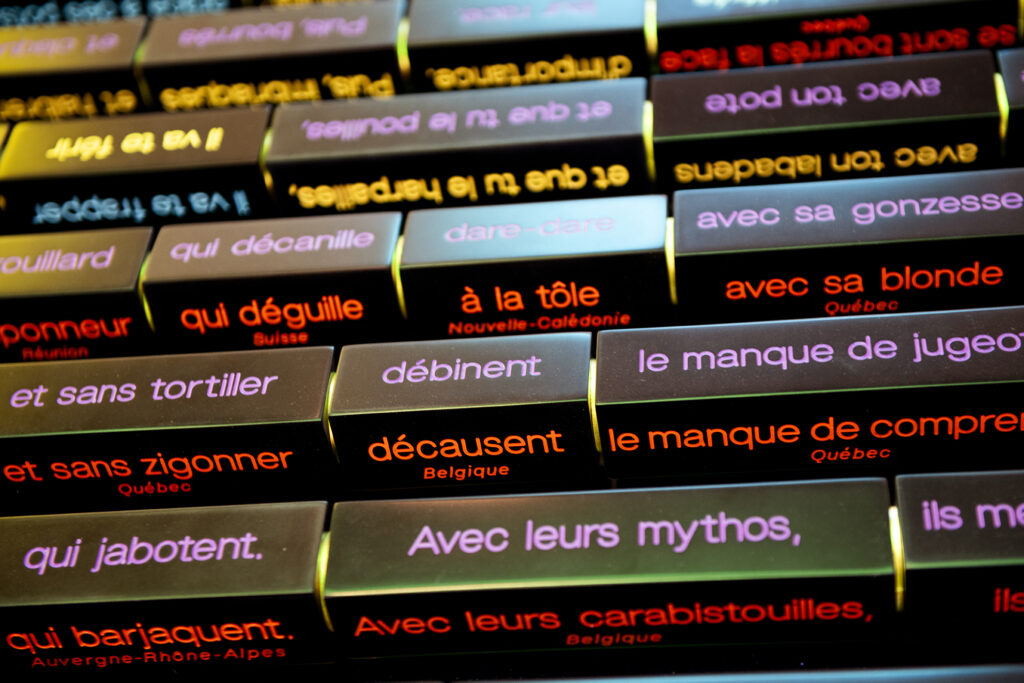
“The Magical library”is devoted to French without border and includes an ink by the Chinese Nobel Prize winner for Litterature who writes in French, Gao Xingjian, courtesy galerie Claude Bernard
I was totally excited to finally get to Villers Cotterêts after a series of mini disasters (the opening visit was cancelled) and an hour and a quarter of driving from Paris. The small town of 10 000 inhabitants, is pretty dreary and the castle which houses the new Cité Internationale de la Langue française stands out like a meringue among the surrounding grey houses. It was built by King François 1er and later given as a hunting lodge, to the Duc d’Orléans by his brother Louis XIV. It is surrounded by the Forêt de Retz which is still a large hunting territory. Since I was early to meet the charming Xavier Bailly, administrator of the new museum, I decided to have a piece of very good tarte and coffee at Chez Alexandre, the coffee shop and spoke to a Belgian couple who had driven especially from Namur. Alexandre refers to Alexandre Dumas, the famous 19 th century novelist, author of “Les Trois Mousquetaires” and “Monte Cristo”, who was born a few hundred meters away and used teh castle and forest in his novels. The Cité was inaugurated on October 30 by President Emmanuel Macron, and very much mediated in the last weeks.
“The adventure of the French language is a journey through time and space on which visitors will see and hear French in all its expressive diversity” is the sentence which introduces the visitor to the galleries and indeed what I preferred in the many interactive rooms devised for adults and children alike, is the sounds of the language. The recreated voice of Jeanne d’Arc or King François 1er, Madame de Lafayette or Toussaint Louverture as well as the different accents used in Québec, Africa or one of the 72 French regional languages. All the cartels come in three languages English, German and French, which is very useful.
Very little space is devoted to the French Academy whose duty is to write the dictionary and defend French. Historian Alain Decaux‘ sword sculpted by Paul Belmondo in 1979, a portrait of Cardinal de Richelieu by Philippe de Champaigne lent by la Sorbonne, are a pale evocation of the Institution. But then the Academicians have not visited the museum yet and a special exhibition might pay them a fair tribute in the future? The general feeling is that all the energy was put into giving a modern image of our language with multi screens and interactive games, on the orthography, the different ways of saying something, the patois and synonyms in Belgian, Canadian and Swiss French. Concerts are taking place at night and in the auditorium, readings are made on contemporary music composed at IRCAM.
I found myself talking to an AI on a screen and when I answered “fake news” to her question, she immediately corrected my English expression in to Infox or fallacieuse. Very amusing and impressive. There are videos and audios of many artists who sing or write in French including Jeanne Moreau of course in “Jules et Jim”. A portrait of a hawker (colporteur) in the 17 th century illustrates the spread of French under the Ancien Régime. It is lent by the Louvre for a few years and will probably be replaced by another painting sometime? Actors rehearse Molière, THE French language by excellence. De Gaulle’s letter of July 19, 1962, to his Minister of the Armed forces, mentioning too many English words is shown in the box “Parlons Français!”.

The Castle of Villers Cotterêts used to be a Poorhouse of the Department of the Seine, created by Napoléon in 1802. It was a place of confinement for beggars from the Paris area and became a retirement home for the poor until 2014 when it was restored for this project.
There are many games to be played with words on screen and kids were having great fun during school vacations. Migrating words for example give the meaning of common French expressions in other countries. The emphasis is constantly made on the evolution of words (you probably noticed I love to invent new words) and their uses in different continents. From the Enlightenment and the famous “Quand l’Europe parlait français” by Marc Fumaroli, to Jules Ferry who was the promoter of free schooling for all children, our attention is alerted to Antoine de Rivarol who in 1783, won the Prize from the Prussian Royal Academy of Sciences for affirming the universality of French, a World language as it is called in the first rooms.
This new Cité is devoted to the French language in a very playful way and it was one of President Macron’s priorities, even though he is the first one to use Franglais in his speeches. The castle built by François 1er, the king of French Renaissance, was also the place where he signed, in August 1539, the Ordinance requesting all institutions to use French (as opposed to latin) for official documents. It is interesting to note that the inauguration takes place at a time when our Minister of Culture, Rima Abdul Malak, is Lebanese and the Perpetual Secretary of the French Academy, writer Amin Maalouf, is also Lebanese. The Middle East, where French was widely spoken until the 1960’s, has kept a very pure language.

The cabin conceived by Stéphane Thidet can be seen next to the cashier in the special exhibition room
The Cité includes visual arts and music and artists in residence can live on the second floor. At the moment, a textile artist, Eveline Cantin-Bergeron, from Québec, is already living on the premises for two months. There are also trainings for alphabetisation teachers. One feels that the Cité is still in progress and that many themes have not been fully developed.
The staff, who is mostly local, is extremely nice and relaxed and slightly dazed by the crowds who visit since November 1. The ambiance is slightly provincial (a compliment in my mind) and it is definitely a promising adventure and Xavier Bailly, who started the project with Philippe Bélaval, then President of Centre des Monuments Français, is so clever and fun that the future looks great.
Cité de Villers Cotterêts is open every day except Monday.
Share this Post





3 Comments on “Villers Cotterêts, the new citadel of the French language, is open”
Merci Laure pour cette « visite » de Villers Cotterêts, vos commentaires sont toujours si intéressants et personnels.
Merci Laure; tes “diary” sont super, toukours super!!!!!!!
Bravo
Rv
Merci Laure; tes “diary” sont super, toujours super!!!!!!!
Bravo
Rv